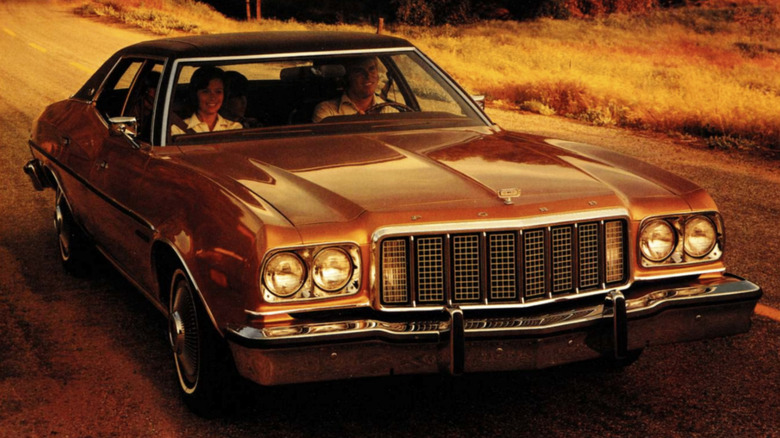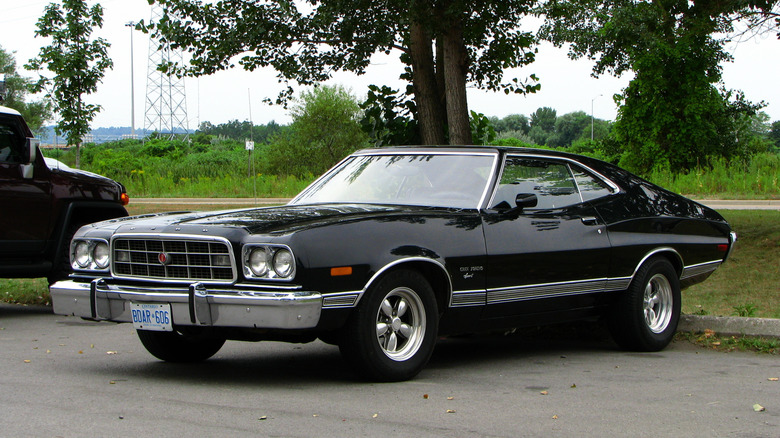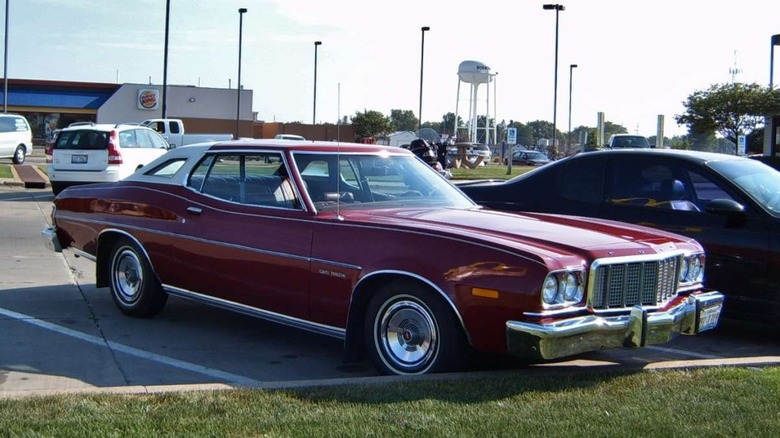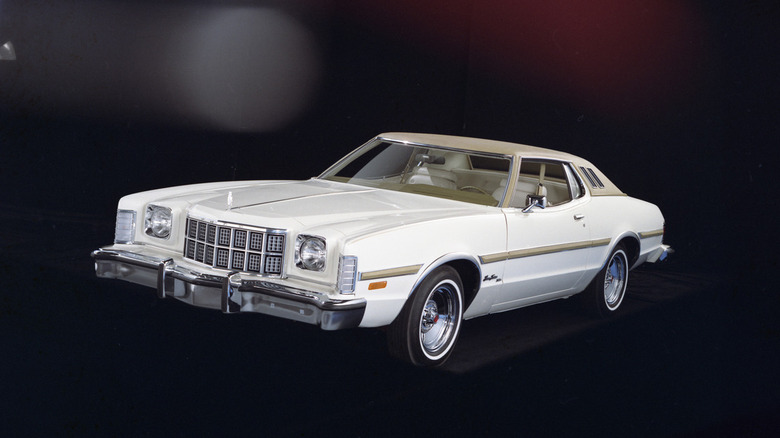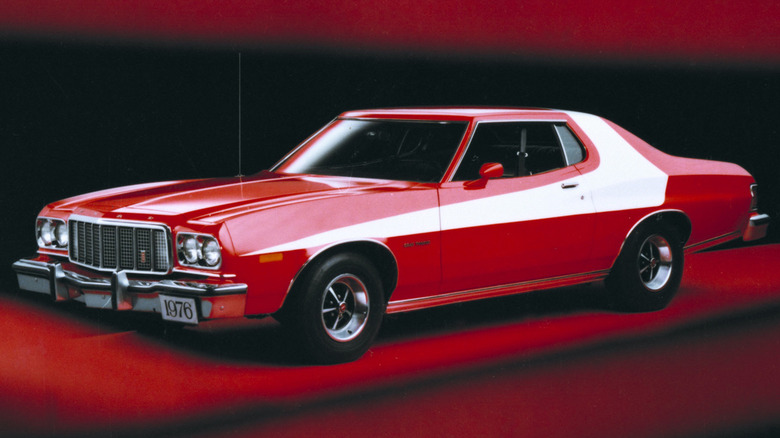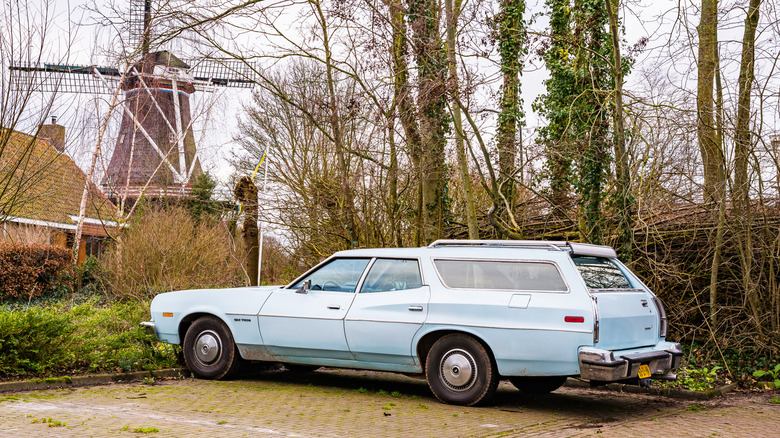Why Did Ford Discontinue The Gran Torino?
Introduced as a luxury-oriented, budget-friendly midsize car for the 1972 model year, the Gran Torino and its sister cars — the Gran Torino Sport and the original Torino (in production since 1968) — represented Ford's premiere affordable midsize coupe of the early to mid-1970s. However, if there's one thing to say about this era, it wasn't very kind to American cars.
The Malaise Era struck the auto industry hard in 1973, following the oil crisis caused by the Yom Kippur War embargo, leading to radical course corrections in automotive development. These changes resulted in long-lasting shifts within both what consumers demanded and what American automakers could feasibly provide in such a short timespan — a fact which claimed many American models throughout the 1970s, the Gran Torino among them in 1976. Ford never published any statement concerning its reasons for discontinuing the Torino line, but we can infer quite a lot about why it failed.
In short, the Ford Torino was discontinued due to three interrelated reasons: A shift towards the compact segment, the Torino's large and somewhat archaic body style, and a lack of investment due to Ford's shifting priorities to follow market trends. To explore these factors deeper, I'll focus on anecdotal evidence and the effects the era had upon larger square bodies in general, as well as draw upon my own years of research into automotive development in this era.
Ford Gran Torino: An acceptable car at the worst possible time
Named for the Italian city of Turin, the Ford Torino started life in 1968, marketed as a more luxurious Fairlane. The Torino saw outstanding success in its initial years, leading Ford to essentially swapping the Fairlane and Torino names in 1970 before discontinuing the Fairlane entirely. Once among the fastest muscle cars, the Torino underwent three generations, with the one we're concerned with lasting from 1972 to 1976 — the Gran Torino trim.
With wheelbases of either 114" or 118", the Gran Torino's platform represented one of the largest "midsize" cars ever marketed, with the 1976 wagon boasting a whopping total length of 223.2 inches. For context, that's about four inches longer than a late-'90s Chevy Suburban. The problem wasn't its length, nor its looks: The 2-door 1973 model year was particularly handsome, for instance. Rather, it was the timeframe Ford introduced it.
This vehicle debuted just one year prior to one of the most dramatic years in automotive history, and this extends beyond just the oil crisis. Ford had only just completely redesigned the Torino with a brand-new fascia — development time invalidated when the U.S. government mandated the infamous "5-mile-per-hour bumper," retroactively canceling decades of bumper development.
This meant that Ford had to sink even more money into redesigning its cars again, with the Torino becoming something far different in comparison to its original 1972 configuration. On top of that, new emissions regulations impacted the entire industry; necessitating not only a body redesign, but a complete overhaul of the engines as well. This set the stage for the downfall of the American full-size barge in the mid-1970s — including the Gran Torino.
Mid-size platform with full-size problems
Though marketed as a midsize, the re-re-designed 1973 Gran Torino was really a full-size car, with at least a 114" wheelbase (depending on configuration), and tipping the scales at 3,677 pounds minimum, exceeding 2 tons. As such, it directly competed with the similarly-proportioned Monte Carlo favorably, with Ford producing 459,057 1973 Torino models according to VIN data recorded on GranTorinoSport.org — of which 407,070 were Gran Torinos — against the Monte Carlo's 233,689 units. However, these numbers wouldn't last into the Malaise Era, with Torino sales plummeting by almost half to 253,096 units by 1976.
This trend continued throughout the American automotive industry due to power figures and gas mileage plummeting to record lows — whereas the adolescent Japanese import market boomed. Honda, for example, didn't require a catalytic converter on its newly-introduced Civic because its Compound Vortex Controlled Combustion (CVCC) system was so emissions-friendly that it didn't even need one to comply with federal regulations.
Such vehicles easily outperformed their larger and thirstier American counterparts (including the Torino's 13 MPG city and 19 highway in 1976), directly leading to dwindling sales numbers in the full-size market. These cars retained positions as dominant luxury offerings, but the Gran Torino was marketed in a more budget-friendly segment while retaining full-size proportions; effectively appealing to neither market as well as a dedicated platform (which Ford offered with the Thunderbird and Mustang II, respectively).
This effectively sealed the fate of the Gran Torino and others like it; its sales gradually falling in favor of more practical, less expensive, and far more fuel-efficient offerings. Such offerings only improved year after year, effectively leading to death by a thousand cuts — or a thousand sales.
Shifting customer sensibilities
The Torino shared its platform with four other vehicles: the Ford Ranchero, Elite, Mercury Cyclone, and Mercury Montego, none of which sold particularly well and were generally marketed outside of their own bracket by Ford. Take the Elite, for instance, which Ford advertised as being "like a Thunderbird," Ford's full-size luxury offering at the time. Even the Gran Torino itself — in the mid-1970s, Ford targeted its midsize (but really full-size) against far smaller and more economical competitors like the Datsun 510 and Toyota Corona.
In other words, the marketing around the Torino's platform touted it as either being essentially a budget-version of a more aspirational car, or a (rather large) economy car — and that was for a very specific reason. Namely, because the customer base who purchased the likes of the Gran Torino migrated to other models to keep up with the changing times. This even occurred within Ford itself, leading the company to offer directly competing models internally. Again, let's refer back to the Mustang II. The very first line of its original brochure states, "the right car at the right time," and Ford marketed it by leaning heavily into its combination of luxury and economy — just like the Gran Torino, with the opening paragraph of its 1976 brochure extolling its "good mileage" (in massive quotes).
This mirrored the general automotive culture at the time, namely the move towards either compacts or personal luxury cars. Of course, to Ford, selling cars was the priority. So rather than lose Torino customers to foreign automakers, Ford offered two appealing alternatives. If a Torino owner wanted a similar feel but with more economy, they could purchase a Mustang II. Or, if they wanted to retain the luxury image and size, go with a Thunderbird instead.
A lack in developmental investment
Let's look at the development history of something far more successful: The Mustang II. Ford had already produced a compact, cheap economy car before the oil crisis even hit: The infamous Pinto. All the 1974 Mustang II did was take the Pinto's underpinnings and stretch it out to fit a bigger engine. This meant Ford wasted little development costs in re-engineering the wheel. It was the perfect car at the perfect time. Ultimately, the Mustang II sold like absolute hotcakes, and likely single-handedly rescued the Mustang name from drowning in the Malaise lagoon.
On the other hand, Ford offered little concessions to its Torino line outside of improving upon its luxury aspects. Unlike the Mustang II, the Torino was a body-on-frame design, so it couldn't feasibly be shrunken down anymore without simply fitting the name on a smaller car. Seeing as Ford already had the Mustang II, it would need to build an entirely new platform from scratch just for the Torino, which simply wouldn't have made much fiscal sense.
As such, the Torino became something of a black sheep, a position evident in its "Starsky & Hutch" appearance — Ford didn't even want the Torino in the role at first, the iconic car being its second choice. Further, what started life as a muscle car gradually but heavily deviated into the mundane, much to its own detriment.
By the mid-1970s, Ford didn't even list the Torino's power figures in its brochure anymore, for instance. Yes, the late-stage Gran Torino was one of pop culture's most famous Fords thanks to its television presence, with a special commemorative edition to boot. But it was a shadow of its former self, and with sales slumping, Ford had no reason to continue its downward spiral.
A failed platform and its slow demise
At last, we come to the Torino's final years. By now, we've established that the full-size car segment suffered heavily under the weight of the oil crisis and its subsequent regulations. This drove customers to seek smaller, more economical alternatives, which caused the boom of the import market and midsize segment. And while considered "midsize," the Torino was functionally as large as a full-size LTD, and not actually that much cheaper, either.
Lastly, the Torino's development and marketing focused more heavily on the luxury end of the spectrum, especially with the Elite, which was advertised as a budget-friendly Thunderbird alternative. This move was very much deliberate, as the personal luxury segment shot up to 22% of domestic automotive sales by 1977, as opposed to just 3% ten years earlier. Meanwhile, full-size luxury car sales dropped dramatically by comparison. This trend ultimately led to the eventual death of the traditional square-body in the 1980s.
These factors most directly contributed to the Torino's inevitable discontinuation and replacement, with Ford retaining the platform for use in the brand-new 1977 LTD II and facelifted Thunderbird. Both of these replacements bear luxury-oriented names predating the Torino itself, but funnily enough, neither car lasted particularly long, with Ford retiring the platform just three years later in 1979 when the second oil crisis hit. Ford marketed the LTD II against its own LTD as a budget-friendly alternative; the (frankly still massive) LTD II similarly failed to meet expectations, and the model ended along with the platform itself. Meanwhile, the Thunderbird received yet another platform, its third in less than a decade, before finally downsizing as a luxury Fox body in 1983.
